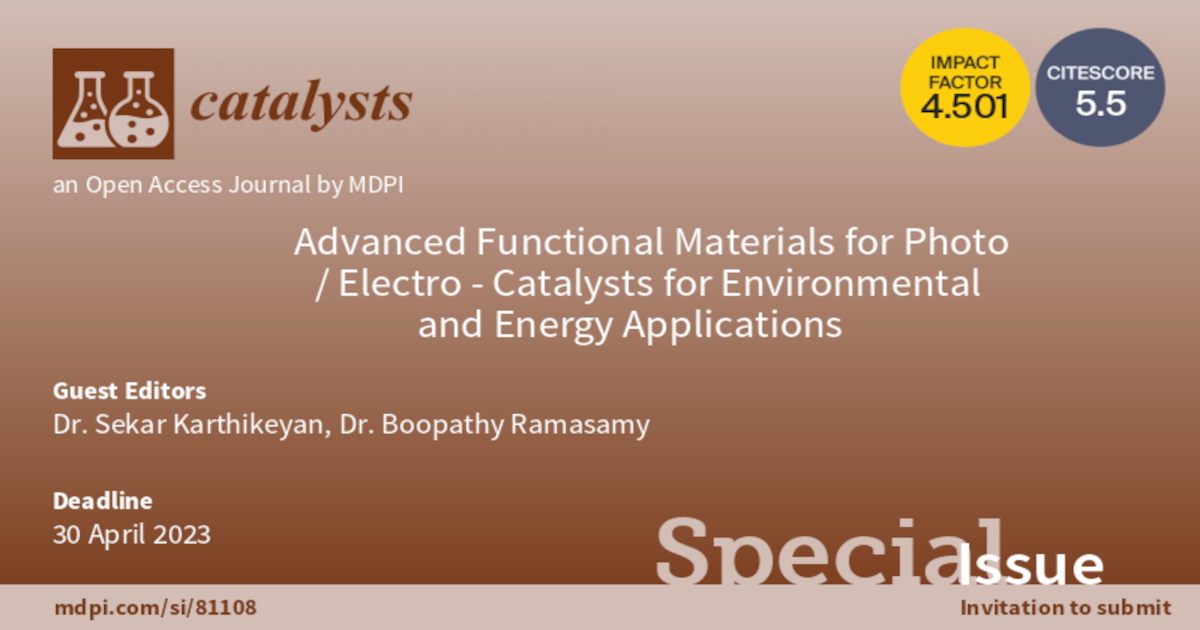Advanced Functional Materials for Photo/Electro-Catalysts for Environmental and Energy Applications
A special issue of Catalysts (ISSN 2073-4344). This special issue belongs to the section "Catalysis for Sustainable Energy".
Deadline for manuscript submissions: closed (30 April 2023) | Viewed by 45625

Special Issue Editors
Interests: material science; surface modification; catalysis; heterogeneous catalysis; sustainable energy; sustainable water
Interests: atmospheric aerosol and its characterization; preparation of low-cost composite materials for wastewater treatment
Special Issue Information
Dear Colleagues,
The aim of the Special Issue is to establish sustainable advanced materials to address the water, atmospheric pollution and energy issues. As described in the Sustainable Development Goals (SDG6), sustainable water and sanitation are becoming increasingly more important in society, and atmospheric CO2 emission, which causes climate change, global warming, and rising sea levels, represents another important issue. As per the Paris agreement, the global warming rate must be kept under 2 °C or lower than that related to pre-industrial level. It is thus urgent to develop innovative advanced materials with broad energy and environmental applications.
This Special Issue covers durable innovative inorganic materials, organic materials, organic/inorganic hybrid materials and advanced functional materials for sustainable water, environmental remediation, solar utilization, and conversion into solar fuels. Papers on electrocatalytic water splitting, CO2 reduction and fuels, and photo(electro)catalytic solar fuels are also welcome.
Dr. Karthikeyan Sekar
Dr. Boopathy Ramasamy
Guest Editors
Manuscript Submission Information
Manuscripts should be submitted online at www.mdpi.com by registering and logging in to this website. Once you are registered, click here to go to the submission form. Manuscripts can be submitted until the deadline. All submissions that pass pre-check are peer-reviewed. Accepted papers will be published continuously in the journal (as soon as accepted) and will be listed together on the special issue website. Research articles, review articles as well as short communications are invited. For planned papers, a title and short abstract (about 100 words) can be sent to the Editorial Office for announcement on this website.
Submitted manuscripts should not have been published previously, nor be under consideration for publication elsewhere (except conference proceedings papers). All manuscripts are thoroughly refereed through a single-blind peer-review process. A guide for authors and other relevant information for submission of manuscripts is available on the Instructions for Authors page. Catalysts is an international peer-reviewed open access monthly journal published by MDPI.
Please visit the Instructions for Authors page before submitting a manuscript. The Article Processing Charge (APC) for publication in this open access journal is 2200 CHF (Swiss Francs). Submitted papers should be well formatted and use good English. Authors may use MDPI's English editing service prior to publication or during author revisions.
Keywords
- solar light
- water depollution
- photo(electro)catalytic H2 production
- photo(electro)catalytic solar fuel production
Benefits of Publishing in a Special Issue
- Ease of navigation: Grouping papers by topic helps scholars navigate broad scope journals more efficiently.
- Greater discoverability: Special Issues support the reach and impact of scientific research. Articles in Special Issues are more discoverable and cited more frequently.
- Expansion of research network: Special Issues facilitate connections among authors, fostering scientific collaborations.
- External promotion: Articles in Special Issues are often promoted through the journal's social media, increasing their visibility.
- e-Book format: Special Issues with more than 10 articles can be published as dedicated e-books, ensuring wide and rapid dissemination.
Further information on MDPI's Special Issue polices can be found here.






